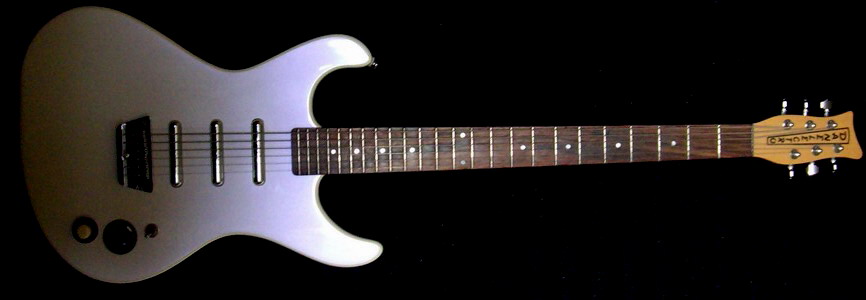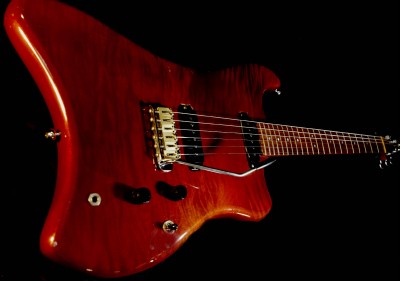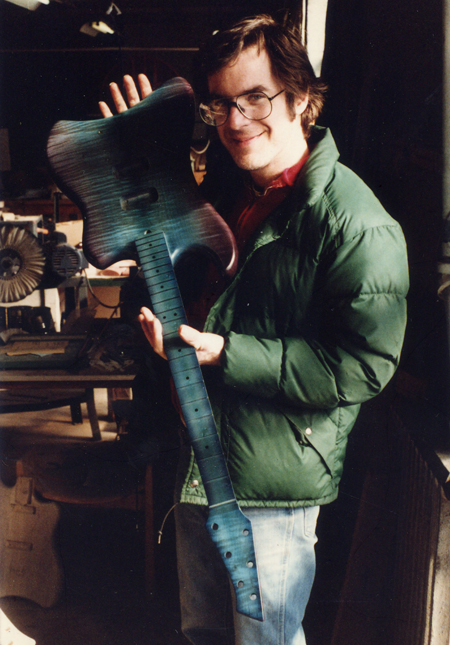
Retired guitar maker Jerry Jones, who made high quality guitars inspired by Danelectro's designs, wrote;

Early Roots
Thomas V. Jones discussed the early roots of the baritone guitar in Premier Guitar Magazine, March 2014:
"A hundred years ago, the Germans produced baritone guitars,” says guitar historian George Gruhn, owner of Gruhn Guitars in Nashville, “but I don’t know much about them. Those were acoustic instruments, of course. They were experimenting with all voices.”
In that group of early baritone-range instruments, I’d also add the mandocello (such as the K series instruments built by Gibson between 1905 and 1920), and maybe even go way back to the 1400s to the viola da gamba—a cello-like instrument with between five and seven strings for lower range, as well as frets (old strings tied around the neck) for better chord intonation. These instruments were the baritones of the mandolin and bowed-instrument families, respectively."
The Danelectro Claim
The quote below is from www.danguitars.com, the self-proclaimed "web's most trusted source for Danelectro."
"Danelectro was the first to introduce the Baritone guitar, in the late 50's and it quickly caught on as a signature sound for Spaghetti Western soundtracks...The Baritone lets you play "tic-tac" bass or chords. This lower tuning can also be used to play many songs from bands that use lower tunings."
(Note: I believe I also saw this same text some time ago at the Danelectro website. There was no information on baritone guitars on the site the last time I looked.)
This quote is from Wikipedia's entry on baritone guitars:
"The Baritone guitar is a variation on the standard guitar, differing with a longer scale length that allows it to be tuned to a lower range. The Danelectro Company was the first to introduce the Baritone Guitar in the late 1950’s. The Baritone Guitar was not originally a hit with either the general public, or the average guitar player. However, its unique sound quickly found its way into Surf music of the day, such as on some of the Beach Boys hits, as well as into background music for many movie soundtracks, especially the Italian Cowboy movies made in Europe starring greats like Clint Eastwood and Lee Van Cleef. The Baritone was also used by country artists and can be heard on recordings by Merl Haggard, Johnny Cash, and Willie Nelson........Gretsch, Fender, Jerry Jones, and many other companies have produced Baritone guitars since the sixties albeit always in low numbers due to low popularity."
The Real Story (probably)
To clarify the confusion, I communicated with several people via e-mail and telephone and luthiers Jerry Jones and Joe Veillette were kind enough to verify the information below.
For our purposes, we define the baritone guitar as being in a range in between the standard guitar and bass guitar and usually tuned either a fourth or fifth (A or B sixth string) below the standard guitar.
In the late 1950s Danelectro made six string basses that included four low strings tuned the same as a four string bass guitar (EADG) with two additional high strings (B and E). These instruments are often confused with baritone guitars and are periodically called baritone guitars to this day. The Danelectro claims are actually about Bass VI type instruments (which Danelectro developed before Fender), not the contemporary baritone guitar. I call the early Danelectros and the Fender Bass VI "Bass VI type instruments" to distinguish them from baritone guitars.

Retired guitar maker Jerry Jones, who made high quality guitars inspired by Danelectro's designs, wrote;
"To be clear, the Danelectro Co. never made a baritone guitar. Their only offering was a six-string bass (never referred to as baritone) which was tuned an octave down like a normal bass with added high B and E strings. The Dano's six-string bass was meant to played as a bass and as an alternative to Fender’s bass with the added bonus of two extra strings. Obviously, musicians saw the usefulness of Danelectro’s bass differently and adapted it for single musical lines or adding an attack component when mixed with the upright bass."
According to Wikipedia "The Fender VI was released in 1961, and followed the concept of the Danelectro six-string bass released in 1956, having six strings tuned E to E, an octave below the Spanish guitar."

"I soon lost interest in architecture & moved from Brooklyn to Grahamsville, NY, where I made acoustic guitars until mid 1975. At that time I co-founded Veillette-Citron Guitars with my friend & fellow architectural student Harvey Citron. The company did well, selling to many notable players. In 1978, John Sebastian asked us to build a baritone guitar, resulting in the VC Shark. That began my fascination with different scale lengths & string tensions, which still marks many of my designs....
In 1991, I started Woodstock Music Products with Stuart Spector, making Spector basses & starting a line of Veillette electric & baritone guitars. When we parted company in mid 1995, development began on the current line of hybrid "acoustic/electric" Veillette Guitars. Around that same time, Michael Tobias & I co-designed the Avante acoustic, baritone, and bass guitars for Alvarez Guitars. I also developed the Deep 6 Baritone neck, a no-modification conversion for Strats or Teles, & the Deep 6 Plus, a 7-String guitar with a longer scale for enhanced tonal balance on all strings, including the usually weak low B. These Deep 6 products are available from WD Music."
"Like George Gruhn, Veillette contends that the first Danelectros were just 6-string basses. “Same with the Fender VI,” he says. “Sebastian came to us wanting a shorter scale—because 30" is a lot of neck!
“We had the first one that was conceived and sold as a baritone,” Veillette continues. “Then the Danelectro people came in trying to copyright the name ‘baritone,’ which was ridiculous. What stopped them was our magazine ad from 1980. We had to do something … It cost me real money to keep making baritones for a while as we fought that. Other people were making what they called baritones, but two-thirds of my line was baritones—we’ve been more dependent on it than any other manufacturer.”"

John Sebastian at the Veillette-Citron shop with a Baritone in the very early 80's
Vintage Guitar magazine tells John Sebastian's story:
"..Still having problems with MGM, who released a live bootleg, [former Loving Spoonful singer-guitarist John] Sebastian reasoned, “I’ve got to have a decent live album out there.” In ’71, he put out Cheapo-Cheapo Productions Presents Real Live John Sebastian. Accompanied only by pianist Paul Harris, Sebastian mixed new songs with Spoonful songs, folk-blues, rockabilly, and doo-wop oldies, in an intimate, spontaneous set highlighting his self-contained fingerpicking style. ....Another instrument that makes an appearance on the live album is a “guitar-bass” designed by Dan Armstrong. Sebastian details: “Dan’s idea was to use two bass strings on the bottom E and A, tune the two middle strings an octave up, the way Nashville tuning would be, and then the high B and E were back to a normal guitar. So you’ve got information from three octaves.”
This was a precursor to the so-called “baritone guitar” that Sebastian helped pioneer. “Even in the Spoonful, we were capoing a Fender 6-string bass,” he points out. “So I went back to doing that, playing by myself, to make a bigger sound. I had Tom Vinci make a set of strings that went A to A. Then I talked to Villette Citron, and brought my Guild Thunderbird down – the ‘shark’ shape – and they designed an instrument with about a 29? scale. Joe Villette and Harvey Citron went their separate ways, and I’ve used instruments from both guys. Eventually, Villette came up with a 27? scale, and said, ‘What about B to B?’ Because my other problem was, with an .080 for a bass string and a .016 on the top, I couldn’t get through a tour with a set of fingernails.”
Despite some claims and rumors, retired luthier Jerry Jones does not claim to be the first baritone guitar maker. He wrote:
"When I offered my first baritones, I was unaware that Joe Veillette and Harvey Citron had made a few baritone guitars for John Sebastian. John Sebastian was an early adopter of the baritone guitar and in discussions with him, he suggested that Ry Cooder was among the very first to use something tuned like a baritone.
My own building dates back to 1988 when I sold my first baritone to Jimmie Vaughan. Jimmie had already been using 6-string bass for recording and quickly picked up on the usefulness of the baritone concept. After that, baritone sales took off and quickly outpacing our six-string bass production.
Nothing is ever really created in a vacuum and so I’ll leave it to others to argue about who offered the first production baritones."
Recent History
Starting in the 1980s, post-punk avant hard rock bands such as Sonic Youth and the Butthole Surfers started tuning their guitars down to get a heavier, bassier tone. In the mid-1990s the seven-string was popularized by thrash-metal-funk bands such as Limp Bizkit and Korn. By the end of the decade the baritone guitar (and the seven-string) was used by many of the nu-metal, death metal and other heavy bands. The best known player for the baritone was Mike Mushok of Staind.
Your feedback and questions will guide the future of this site.
Mike 064 Freeman
Premier Guitar Magazine Baritone Guitar Article
Vintage Guitar Magazine article on John Sebastian
Article on The Fender Bass VI from The Unique Guitar Blog Wikipedia Baritone Guitar Article
Wikipedia Fender Bass VI Article
Vintage Guitar Magazine article on the Fender Bass VI